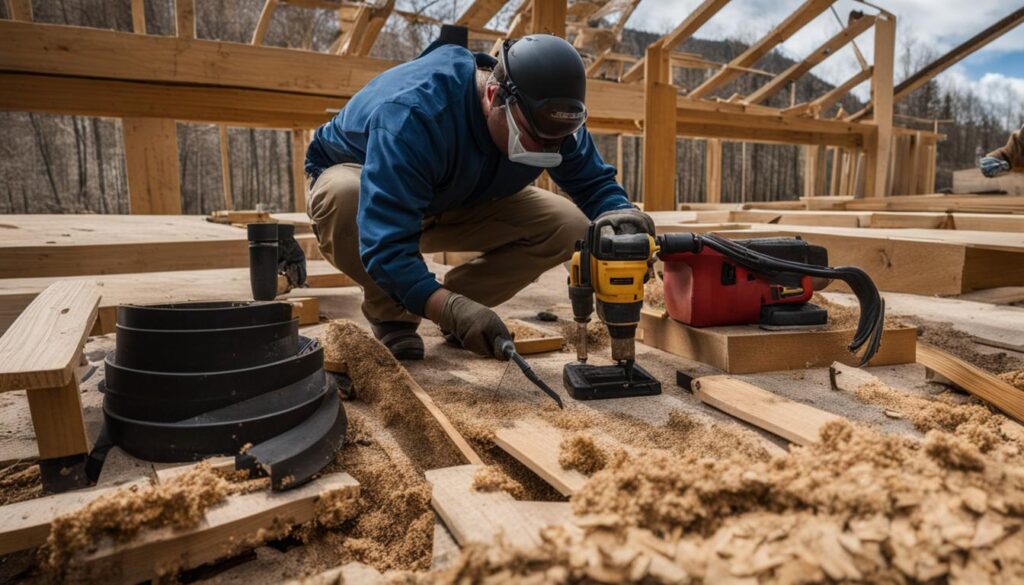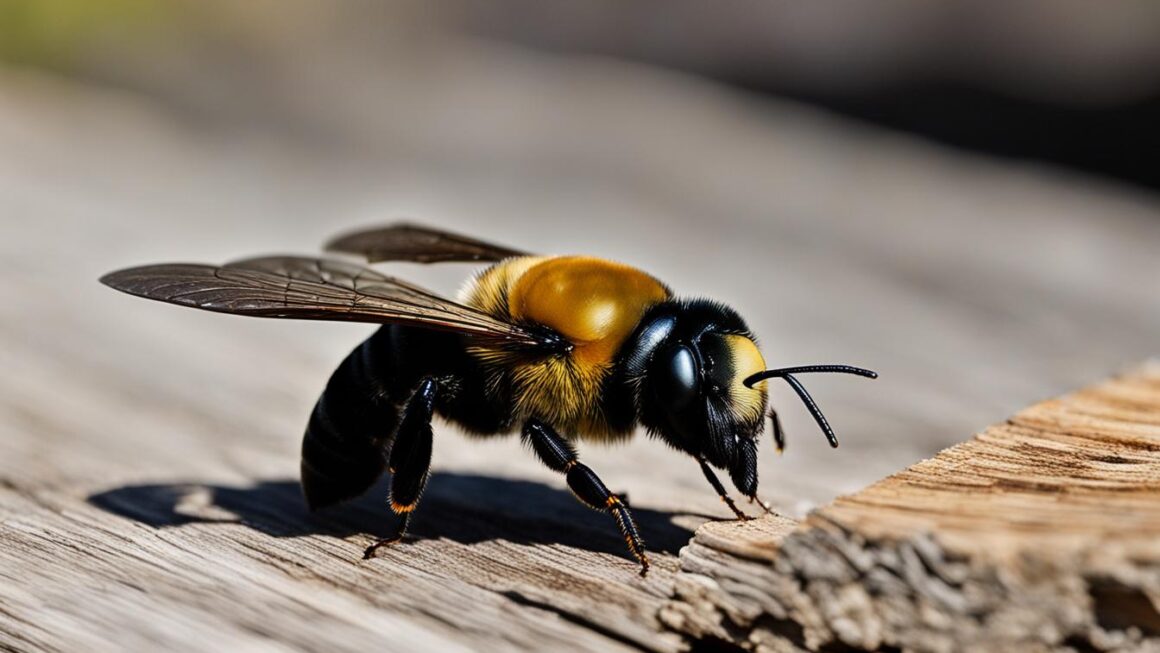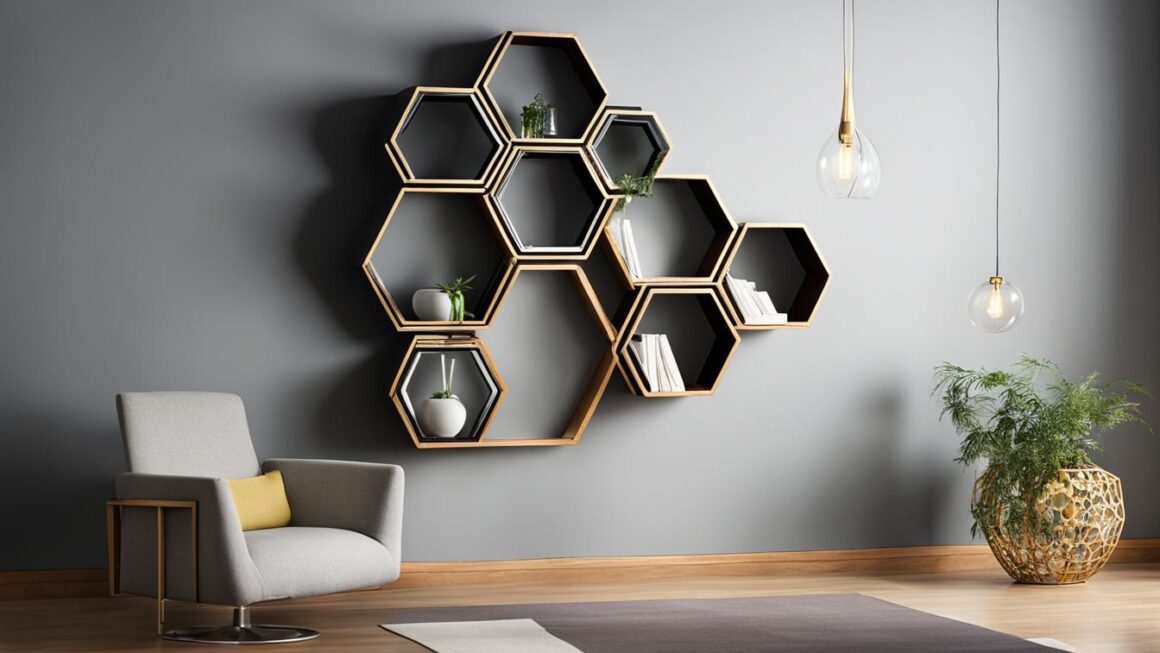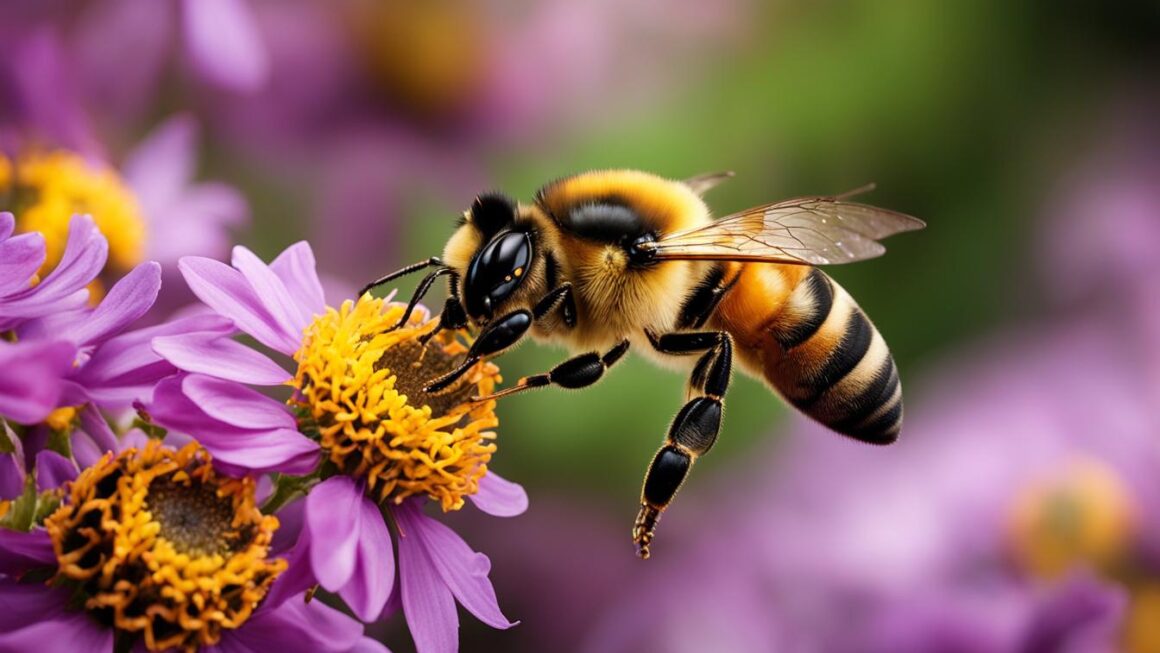Carpenter bees can be a nuisance when they start drilling holes in wood structures like decks, outdoor furniture, and siding. In this article, we will explore effective methods to get rid of carpenter bees and prevent infestations.
Key Takeaways:
- Understanding the behavior of carpenter bees is crucial for effective elimination.
- Identifying signs of a carpenter bee infestation can help you take early action.
- Preventive measures such as protecting wood structures and regular maintenance can deter carpenter bees.
- Natural repellents and DIY removal methods can provide non-toxic solutions.
- In severe cases, professional pest control may be necessary.
Understanding Carpenter Bees
Carpenter bees, also known as Xylocopa virginica, are native insects that resemble bumble bees but have a bald abdomen. Unlike social bees, they are solitary and not aggressive towards humans. The female carpenter bee excavates tunnels in wood to create brood cells for her eggs. The males, on the other hand, are territorial and may divebomb if their nesting sites are disturbed.
These bees are known for their drilling behavior, which can cause damage to wood structures like decks, outdoor furniture, and siding. They create perfectly round half-inch holes in the wood, leaving behind sawdust or coarse sawdust beneath the holes. Identifying these signs is crucial for taking appropriate action to prevent further damage.
While carpenter bees play an important role as pollinators, their drilling activities can pose a nuisance and potentially weaken the integrity of wooden structures over time. Understanding their behavior and implementing effective control methods can help homeowners protect their property and mitigate any potential damage caused by these solitary bees.
“Carpenter bees are fascinating creatures that have adapted to excavate wood for their nests. Although their drilling behavior may cause structural issues, it’s important to remember that they are crucial pollinators in our ecosystem.”
To further comprehend the impact of carpenter bees, let’s take a closer look at the comparison table below:
| Characteristic | Carpenter Bees | Solitary Bees |
|---|---|---|
| Behavior | Drill tunnels in wood to create brood cells | Create individual nests in various locations |
| Aggressiveness | Non-aggressive towards humans | Non-aggressive towards humans |
| Pollination | Important pollinators | Important pollinators |
| Structural Damage | Potential weakening of wooden structures | No significant structural damage |
By gaining a better understanding of carpenter bees, homeowners can take proactive measures to prevent infestations, protect their wooden structures, and coexist with these important pollinators.
Signs of Carpenter Bee Infestation
Carpenter bees can be a nuisance when they start drilling holes in wood structures. To effectively deal with these pests, it’s important to be able to identify the signs of a carpenter bee infestation:
- Perfectly round half-inch holes: One of the most obvious signs of carpenter bee activity is the presence of perfectly round half-inch holes in wood surfaces. These holes are usually located near the edges of the wood.
- Sawdust or coarse sawdust beneath the holes: Carpenter bees create tunnels by drilling into wood, and they often leave behind sawdust or coarse sawdust beneath the entrance holes. This debris is a telltale sign of their presence.
- Aggressive male bees: Male carpenter bees are territorial and will often hover around their nesting sites. If you see male bees being aggressive or divebombing near wood structures, it could be a sign of an infestation.
Identifying these signs early on can help you take prompt action to prevent further damage and eliminate carpenter bee infestations. If you suspect a carpenter bee problem, it’s recommended to consult with a professional pest control company for effective removal and prevention strategies.
Prevention Methods for Carpenter Bees
Carpenter bees can be a nuisance and cause damage to wood structures over time. To prevent carpenter bee infestations and protect your wood structures, there are several effective prevention methods you can implement.
Protect Vulnerable Areas
One key prevention method is to protect vulnerable areas of wood, such as the ends of timbers, with wire screening or metal flashing. These materials act as barriers, making it difficult for carpenter bees to drill holes and create nests. Additionally, using vinyl, aluminum, or cement board siding can deter carpenter bees from infesting your property.
Regularly Maintain and Treat Wood Surfaces
Regular maintenance and treatment of wood surfaces can make them less attractive to carpenter bees. Consider regularly painting or varnishing exposed wood to create a protective layer. The smell and taste of the paint or varnish can deter carpenter bees from drilling into the wood. It’s important to follow proper application techniques and use high-quality products for the best results.
Keep Surrounding Areas Clear
Another preventive measure is to keep the surrounding areas clear of potential nesting sites. Remove or relocate old, untreated wood that may attract carpenter bees. Trim and maintain trees and shrubs that are close to wood structures, as they can provide easy access for carpenter bees to infest. By eliminating attractive nesting sites, you can reduce the risk of carpenter bee infestations.
| Prevention Method | Description |
|---|---|
| Protect Vulnerable Areas | Use wire screening or metal flashing to protect vulnerable areas of wood. |
| Regularly Maintain and Treat Wood Surfaces | Regularly paint or varnish exposed wood surfaces to make them less attractive to carpenter bees. |
| Keep Surrounding Areas Clear | Remove or relocate old, untreated wood and maintain trees and shrubs that are close to wood structures. |
By implementing these prevention methods, you can reduce the likelihood of carpenter bee infestations and protect your wood structures. Stay vigilant and regularly inspect your property for signs of carpenter bees to take appropriate action if needed. Remember, prevention is key to avoiding costly damage and the need for extensive repairs.
Natural Ways to Control Carpenter Bees
If you’re dealing with a carpenter bee infestation and prefer to use natural methods for control, there are several options available. These methods are non-toxic and can be effective in repelling and removing carpenter bees from your property.
Citrus oil: Citrus oil, such as orange oil or lemon oil, can be used as a natural repellent for carpenter bees. Mix a few drops of citrus oil with water and spray it on the affected areas. The strong smell of citrus oil can deter carpenter bees from nesting in wood.
Loud noises and vibrations: Carpenter bees are sensitive to loud noises and vibrations. By playing loud music or creating vibrations near infested areas, you can discourage them from nesting. This method is best suited for outdoor spaces.
Carpenter bee traps: Using carpenter bee traps can be an effective way to capture and remove these insects without using harmful chemicals. These traps are designed to attract carpenter bees and trap them inside. Place the traps near the affected areas to lure the bees away from your wood structures.
| Pros | Cons |
|---|---|
| Non-toxic | May not eliminate all carpenter bees |
| Safe for the environment | May require repeated application |
| Easy to use | Works best for small infestations |
“Using natural repellents and traps can be a safe and effective way to control carpenter bees without harming the environment. These methods may not completely eliminate all carpenter bees, but they can help reduce the infestation and prevent further damage to your wood structures.”
If needed: Natural Carpenter Bee Control
If you’re looking for natural ways to control carpenter bees, there are a few additional methods you can try:
- Planting bee-repellent plants such as mint, eucalyptus, or lavender around your property.
- Creating physical barriers using wire mesh or aluminum foil to cover vulnerable wood surfaces.
- Maintaining regular wood maintenance by painting or varnishing exposed surfaces to make them less attractive to carpenter bees.
Remember, natural methods may take time and require consistent application for optimal results. If the infestation persists or becomes unmanageable, it may be necessary to consult a professional pest control service for further assistance.
Using Pesticides for Carpenter Bee Extermination
When dealing with larger infestations, pesticides can be an effective solution for carpenter bee extermination. There are different types of pesticides available for this purpose, each with its own advantages and considerations. It’s important to choose the right pesticide and use it in accordance with the instructions to ensure the best results and minimize environmental impact.

One type of pesticide commonly used for carpenter bee extermination is a spray formulation. These sprays can be applied directly into the bee holes, coating the interior and killing the bees inside. It’s important to ensure thorough coverage, spraying directly into each hole and any surrounding areas where bees may be active.
Insecticidal dust is another effective option for long-term infestations. This type of pesticide is typically applied using a duster or puffer. The fine particles of dust penetrate the bee tunnels, reaching even hard-to-reach areas. The dust clings to the bees and larvae, killing them and preventing future generations from developing.
Important Considerations When Using Pesticides
- Always read and follow the instructions provided by the pesticide manufacturer.
- Wear appropriate protective gear, such as gloves, goggles, and a mask, when applying pesticides.
- Avoid applying pesticides on windy days to minimize potential drift and unintended exposure.
- Keep children and pets away from treated areas until the pesticide has dried completely.
- Dispose of empty pesticide containers according to local regulations.
By using pesticides properly and responsibly, you can effectively eliminate carpenter bees and protect your wood structures from further damage.
Plugging Carpenter Bee Holes
Carpenter bee holes can be a persistent problem if left unaddressed. After treating the holes with an insecticide, it’s important to take the necessary steps to seal the tunnels and prevent future infestations. By properly plugging carpenter bee holes, you can protect your wood structures from further damage and discourage these pests from returning.
To seal the tunnel entrances, you can use wood putty or caulking compound. Apply the chosen material to completely fill the holes, ensuring a tight seal. This will prevent moisture intrusion, wood decay, and the reuse of the tunnels by carpenter bees. Make sure to follow the manufacturer’s instructions on using the chosen sealing compound for optimal effectiveness.
By plugging carpenter bee holes, you not only address the immediate issue but also create a barrier that deters future nesting. This is an essential step in preventing carpenter bee infestations and protecting the integrity of your wood structures. Regular inspection and prompt sealing of any newly formed holes will help maintain a bee-free environment.
Benefits of Plugging Carpenter Bee Holes:
- Prevents moisture intrusion and wood decay
- Discourages future nesting by closing off access points
- Preserves the structural integrity of wood structures
- Helps maintain a bee-free environment
Repairing Carpenter Bee Damage
Carpenter bee damage to wood structures can range from cosmetic issues to potentially compromising the structural integrity of the affected areas. Understanding the extent of the damage is crucial in determining the appropriate repair methods and ensuring the long-term stability of the wood.
Before beginning any repairs, it’s important to address the carpenter bee infestation itself. Make sure all bees have been eliminated and that the treated holes are sealed to prevent reinfestation. Once this has been done, you can proceed with repairing the damage.
Assessing the Damage
To effectively repair carpenter bee damage, start by assessing the extent of the structural issues. Look for signs of weakened or compromised wood, such as sagging beams, cracking, or crumbling sections. Also, check for any moisture damage or rot that may have occurred as a result of the infestation.
If the damage is localized and minor, you may be able to address it by filling the holes and superficial surface damage with an appropriate wood filler. However, if the damage is extensive or affects load-bearing areas, it’s advisable to consult with a professional contractor or structural engineer to ensure proper repairs are made.
Repair Methods
The repair methods for carpenter bee damage will depend on the severity and location of the damage. Here are some common approaches:
- Wood Filler: For minor surface-level damage, using a wood filler can help restore the appearance of the wood. Make sure to choose a filler that is compatible with the type of wood you are repairing. Follow the manufacturer’s instructions for application and allow adequate drying time.
- Wood Replacement: If the damage is more significant or affects load-bearing areas, it may be necessary to replace sections of the damaged wood. This should be done by a professional to ensure proper structural integrity.
- Reinforcement: In cases where the structural stability of the wood has been compromised, reinforcement techniques may be required. This can involve adding additional support, such as braces or sistering new beams to existing ones.
It’s important to note that while repairing carpenter bee damage is essential, addressing the underlying causes of the infestation is equally important. By taking preventive measures to protect wood structures and regularly inspecting for signs of carpenter bees, you can minimize the risk of future damage and the need for extensive repairs.

Seeking Professional Pest Control
If you are dealing with large-scale carpenter bee infestations or difficult-to-reach nesting areas, it is advisable to seek the help of a professional pest control company. These experts have the necessary knowledge, experience, and tools to effectively remove carpenter bees and prevent their return. By consulting with a professional, you can ensure thorough treatment and long-term solutions to protect your property.
Professional pest control companies employ various methods to eradicate carpenter bees, tailored to the specific situation. They may use sprays or dust insecticides to target active nests and treat affected areas. These professionals have a deep understanding of carpenter bee behavior and can accurately identify nesting sites, even in hidden or hard-to-reach areas.
Additionally, professional pest control technicians can provide advice on preventive measures to safeguard your property against future infestations. They can recommend wood treatments, structural repairs, and other strategies to minimize the risk of carpenter bee damage. By relying on their expertise, you can have peace of mind knowing that your carpenter bee problem is being handled effectively.
In summary, when facing significant carpenter bee infestations or situations where DIY methods are not yielding results, it is best to enlist the help of professional pest control services. Their specialized knowledge, targeted treatments, and preventative measures can ensure the complete removal of carpenter bees and the protection of your property.
Carpenter Bee Prevention Tips
To protect your wood structures from future carpenter bee infestations, it’s important to take proactive measures and implement effective prevention strategies. Here are some tips to help you prevent carpenter bees from causing damage:
1. Regularly inspect and seal potential entry points
Regularly inspect areas around your property for any potential entry points or holes in wood structures. Carpenter bees can exploit even the smallest cracks and crevices, so it’s important to seal them off. Use wood putty or caulking compound to fill any gaps and prevent bees from accessing the wood.
2. Use protective coatings on exposed wood surfaces
Protective coatings such as paint or varnish can make the wood surfaces on your property less attractive to carpenter bees. These coatings create a barrier that can deter bees from nesting in the wood. Make sure to regularly maintain and reapply these coatings to ensure their effectiveness.
3. Consider using less appealing hardwoods
Some hardwoods, such as cedar or redwood, are less appealing to carpenter bees. Consider using these types of wood for any new construction or when replacing damaged wood structures. By using less appealing materials, you can reduce the risk of carpenter bees infesting your property.
4. Remove old wood and debris
Carpenter bees are attracted to old, weathered wood and debris. Clearing out any old wood or debris from your property can help deter these insects from nesting. Regularly inspect and clean up outdoor areas such as sheds, fences, and firewood piles to minimize attractive nesting sites.
| Prevention Tips | Implementation |
|---|---|
| Regularly inspect and seal potential entry points | Fill gaps and cracks with wood putty or caulking compound |
| Use protective coatings on exposed wood surfaces | Apply paint or varnish regularly |
| Consider using less appealing hardwoods | Choose cedar or redwood for construction |
| Remove old wood and debris | Clean up outdoor areas regularly |
By following these prevention tips, you can protect your wood structures from carpenter bee infestations and minimize the risk of damage. Taking proactive measures is essential in maintaining the integrity and longevity of your property.
DIY Carpenter Bee Removal
If you prefer to handle carpenter bee removal on your own, there are several effective DIY methods you can try. These methods can help you control and eliminate carpenter bee infestations without the need for professional assistance. It’s important to follow safety guidelines and take necessary precautions when attempting DIY carpenter bee removal.
Non-Toxic Repellents
One DIY method for carpenter bee removal is using non-toxic repellents. Citrus oil or almond oil can be applied to wood surfaces to repel carpenter bees. These oils work as natural deterrents and can be effective in preventing bees from nesting in the treated areas. Apply the repellents regularly, especially during the bee’s active season, for better results.
Carpenter Bee Traps
Creating carpenter bee traps is another DIY method that can help you capture and remove these insects. Build or purchase carpenter bee traps and place them near known nesting areas. The traps are designed to attract the bees and trap them inside, preventing them from causing further damage. Be sure to check the traps periodically and dispose of any trapped bees.
Sealing Holes After Treatment
After treating carpenter bee holes with an appropriate insecticide, it’s essential to seal the holes to prevent reinfestation. Wait for a week after treatment to ensure the bees are no longer active. Then, use wood putty or caulking compound to seal the tunnel entrances. This will help prevent moisture intrusion, wood decay, and reuse of the tunnels by other bees.
By following these DIY methods, you can effectively control and remove carpenter bees from your property. However, if the infestation is extensive or you are unsure of how to proceed, it’s always best to consult with a professional pest control company for expert advice and assistance.
Conclusion
In conclusion, carpenter bees can be a nuisance and cause damage to wood structures. However, by understanding their behavior and implementing effective control methods, you can successfully manage and eliminate carpenter bee infestations.
Prevention is key to carpenter bee control. By protecting vulnerable areas of wood and regularly maintaining exposed surfaces, you can make your property less attractive to these insects. Utilizing natural methods, such as non-toxic repellents and loud noises, can also deter carpenter bees from nesting in the first place.
If you’re dealing with a larger infestation or are unable to effectively control carpenter bees on your own, it’s advisable to seek the help of a professional pest control company. They have the expertise and tools to remove carpenter bees safely and provide long-term solutions to prevent their return.
Remember, taking action is essential to protect your property from further damage. Whether you choose natural methods, DIY removal, or professional pest control, implementing suitable carpenter bee control methods will help maintain the integrity of your wood structures and provide peace of mind.
FAQ
Are carpenter bees aggressive?
No, carpenter bees are not aggressive towards humans.
How can I identify a carpenter bee infestation?
Look for perfectly round half-inch holes in wood surfaces, sawdust or coarse sawdust beneath the holes, and aggressive male bees around nesting sites.
What are some prevention methods for carpenter bees?
Protect vulnerable areas of wood with wire screening or metal flashing, use siding materials like vinyl or aluminum, and regularly paint or varnish exposed wood surfaces.
Are there natural ways to control carpenter bees?
Yes, you can use non-toxic liquids like citrus oil or almond oil to repel carpenter bees, create traps, and use loud noises and vibrations to discourage them.
Can pesticides be used to exterminate carpenter bees?
Yes, carpenter bee sprays and insecticidal dust can be effective for carpenter bee extermination.
How can I plug carpenter bee holes?
Treat the holes with an insecticide, wait for a week, and then seal the tunnel entrances with wood putty or caulking compound.
What should I do if the carpenter bee damage is extensive?
Contact a professional pest control company to assess the situation and provide appropriate solutions.
When should I seek professional pest control for carpenter bees?
In cases of large-scale infestations or difficult-to-reach areas, it’s advisable to seek professional help.
How can I prevent future carpenter bee infestations?
Regularly inspect and seal potential entry points or holes in wood structures, use protective coatings on exposed wood surfaces, and consider using less appealing hardwoods.
What DIY methods can I try for carpenter bee removal?
You can use non-toxic repellents, create traps, and seal holes after treating them with insecticides.




